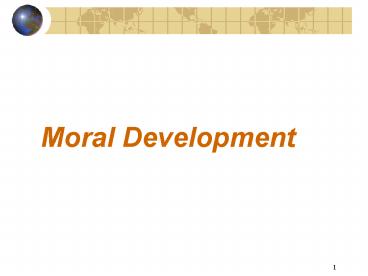Moral Development - PowerPoint PPT Presentation
1 / 17
Title:
Moral Development
Description:
Kohlberg came up with 3 levels of moral development with two stages at each level. ... Secured attached infants are more sociable, more tolerant of frustration and ... – PowerPoint PPT presentation
Number of Views:55
Avg rating:3.0/5.0
Title: Moral Development
1
Moral Development
2
- Refers to changes in the ability to reason about
what is right and what is wrong in a given
situation. - Lawrence Kohlberg has a stage theory of moral
development. - Kohlberg came up with 3 levels of moral
development with two stages at each level.
Result- six stages of moral development (Table
8.3 page 309 OR see class handout)
3
Criticisms of Kohlbergs Theory
- One criticism states that we have to consider the
cross-cultural aspect. - Concern about gender differences in moral
development of morality. Does Kohlbergs theory
apply to females? - Concern with the consistency of moral judgments.
4
EMOTIONAL DEVELOPMENT AND TEMPERAMENT
5
At what age do infants begin to experience and
demonstrate discrete emotions?
- Research in this area focuses on facial
expression outward signs of distinct emotions. - 2 month old infants demonstrate social smiling in
response to human faces. - 2 month old infants show pain expressions more
than anger expressions. A few months later they
show anger more frequently than pain. - 3- 4 month old infants show laughter.
6
- 3-months they become upset when their mothers are
upset. - As they grow older, infants acquire increasing
capacities to read the emotional expressions of
others. - 8- 10 months, they actively seek information
about other peoples feelings and begin to
demonstrate growing understanding of their own
mental states and those of others. - Age 1, when a child falls he/she will look to
their caregiver and depending on their
caregivers reaction they will either cry or
laugh.
7
WHAT IS TEMPERAMENT?
- Stable individual differences in characteristic,
mood, activity level, and emotional reactivity. - Differences in temperament are present early in
life
8
- 3 categories of temperaments
- Easy children (40) generally cheerful, adapt
readily to new experiences and quickly
establishes routines for many activities of daily
life. - Difficult children (10) are irregular in daily
routines, are slow to accept new situations or
experiences and show negative reactions more than
other infants. - Slow--to-warm-up-children (15) relatively
inactive and apathetic and show mild negative
reactions when exposed to unexpected event or new
situations. - Remaining 35 cannot be classified.
9
ATTACHMENT
10
- Strong affectional bond between infants and their
caregivers - According to a theory developed by John Bowlby,
attachment involves a balance b/w infants
tendencies to seek to be near to their caregivers
and their willingness to explore new
environments. - Bowlby contended that the quality of attachment
is revealed by the infants reaction to
separation b/w themselves and their caregivers,
as well as, their reaction to the return of their
caregiver(s).
11
STRANGE SITUATION TEST
- A situation in which a caregiver leaves a child
alone with a stranger for a few minutes and then
returns. Researchers proposed 4 patterns of
attachment. - Secure attachment
- Ambivalent Attachment
- Avoidant Attachment
- Disorganized attachment
12
SECURE ATTACHMENT
- An appropriate display of distress when
caregivers depart and then a warm and
enthusiastic greeting upon their return. - Parents of these children tend to respond quickly
and appropriately to the behaviors of the child.
- Distress is met with comfort.
13
INSECURE/ AMBIVALENT ATTACHMENT
- Intense clinging and resistance to separation.
When parent returns the child goes b/w approach
and avoidance of the caregiver. - Parents of these children appear inconsistent in
their responses to their child. At times, they
respond appropriately and other times they
respond inappropriately or fail to respond.
14
INSECURE/AVOIDANT ATTACHMENT
- Failure to express distress on departure of
parents and then avoidance of parent on return. - Parents of these babies appear aloof, detached,
rejecting and neglectful. Children learn that
their caregivers are not available and cannot be
trusted.
15
DISORGANIZED ATTACHMENT
- Also called disoriented attachment
- Behavior is inconsistent and contradictory.
Child may begin to approach the returning parent
and then turn away or behave in a confused manner
neither approaching nor avoiding, but rather
freezing.
16
LONG TERM EFFECTS OF ATTACHMENT STYLES
- Secured attached infants are more sociable, more
tolerant of frustration and more flexible and
persistent in many situations. As adults they
able to use their partners as a secure base and
serve as a secure base for their partners when
compared to adults who experienced insecure
attachment as a child. Seen as happier and more
trusting in adult relationships. - People who were avoidantly attached seem to worry
constantly about losing their romantic partners
they didnt trust their caregivers as infants and
dont trust their spouses or lovers when they are
adults.
17
(No Transcript)































